hardware literature
art fiction film music television history language poetry stores tools hardware catalog jmcvey.net
Listed here are history (and future?) of hardware retailing (also ironmongers, eisenwaren, &c.), trade journals, handbooks, etc. Most of these were added ca 2011-12.
![]()
- Regina Lee Blaszczyk. Imagining Consumers: Design and Innovation from Wedgewood to Corning (2000). Blaszczyk’s discussion of the growing expansion of hardware store offerings to compete with chain variety stores, leading to a mimicing, albeit at miniature scale, of department stores, does accurately capture the McVey merchandising trajectory into the 1960s, although it was later abandoned as the store got out of most housewares.

- Ray Bradbury. “The Great American “What am I doing here, and why did I buy that?” Hardware Store.” (1987). In Ray Bradbury, Yestermorrow: Obvious Answers to Impossible Futures. Santa Barbara: Joshua Odell Editions / Capra Press, 1991.
Hardware store as idea/dream merchant.
“So are most of us fearful of thresholding hardware emporiums because, while we may have a love object in mind, we rarely know the name of the damned thing.
It follows then that your prescient 2001 doodad shop must post a sign above the front door : ‘HARDWARE SPOKEN HERE’.”See also entry for Bradbury’s “June 2003: Way in the Middle of the Air,” in The Martian Chronicles (1950) : link

- Gerald Carson. The Old Country Store. New York: Oxford University Press, 1954. xvi+330p.; illustrations, appendix, chapter references, and index.
Book is divided into two parts, treating 1791-1861 and 1861-1921, respectively. Enormously enjoyable, instructive.—
“Stationers printed and bound-up memorandum books for country dealers listing the articles that a general store handled, with room at the left margin for the owner to put down the quantity he wanted before he visited the markets, a wise protection against the blandishments of the Pearl Street drummer with his smooth tongue and tempting loss leaders. At the right side of the page there was space for jotting down the prices paid. Being made of all-rag paper which would stand repeated erasures, the book could be kept and used for years.
One such memorandum book, bound in scuffed old leather and marbled boards, has the title “The Merchant’s Memorandum and Price Book... A general remembrancer for Mercantile Gentlemen... embracing the leading articles of merchandize in common use for the country trade...”Confirms (p154) my sense that daily newspapers devoted considerable coverage to patents issued by the U.S. Patent Office.

- Thomas D. Clark. “The Country Store in American Social History.” Ohio History 60:2 (April 1951) : 126-144
Elegiac in tone, but interesting. I ruminate about E. H. McVey, whose backbround in Indiana must have informed what he did with his hardware store in Annandale (Los Angeles), ca 1910. Eagle Rock at that time may have looked bucolic, but would soon be filled with houses. The hardware/country store genres were subject to constant revision. Restless, he closed the business, started a succession of others (a gas station, lunch counter).
The Ohio Historical Society provides access to this article here.

- Charles N. Crewdson. Tales of the Road (illustrated by J. J. Gould). Chicago: Thompson & Thomas, 1905
multiple copies via hathitrust : link
J(oseph). J. Gould (1880-1935?), Philadelphia, illustrator for Lippincott’s in the 1890s, and later for Saturday Evening Post : link
more, for Joseph J. Gould, Jr. (the same) at the Metropolitan Museum of Art : link (accessed 20230419)“One day, pretty soon after I had braced the old man to send me out, a merchant in Iowa wrote in that he wanted to buy a bill of clothing. They looked him up in Dun’s and found that he was in the grocery business. My father didn’t wish to go out — the town was in his territory. I overhead the old man in the office say to him: ‘Let’s send Chim.’
“Well, Jim started that night. They told me to take a sleeper, but I sat up all night to save the two dollars. I didn’t save much money, though, because in the middle of the night I got hungry and filled up on peanuts and train bananas. The town was up on a branch and I didn’t get there until six the next day. When I reached there, I went right up to the man’s store. You ought to have seen this place! The town was about seven hundred, and the store just about evened up with it — groceries and hardware. I got a whiff from a barrel of sauer kraut as I went in the door; on the counter was a cheese case; frying pans and lanterns hung down on hooks from the ceiling; two farmers sat near the stove eating sardines and crackers. No clothing was in sight and I said to myself: ‘Well, I’m up against it; this man can't buy much; he hasn’t any place to put it if he does.’ But I’ve since learned one thing: You never know who is going to buy goods and how many on the road must learn that the man who has nothing in his line is the very man who can and will buy the most, sometimes, because [115] he hasn’t any. And besides, the little man may be just in the notion of spread himself.”“A young man was counting eggs back near the coal oil can. He was the only one around who seemed to have anything to do with the store...”
114 : link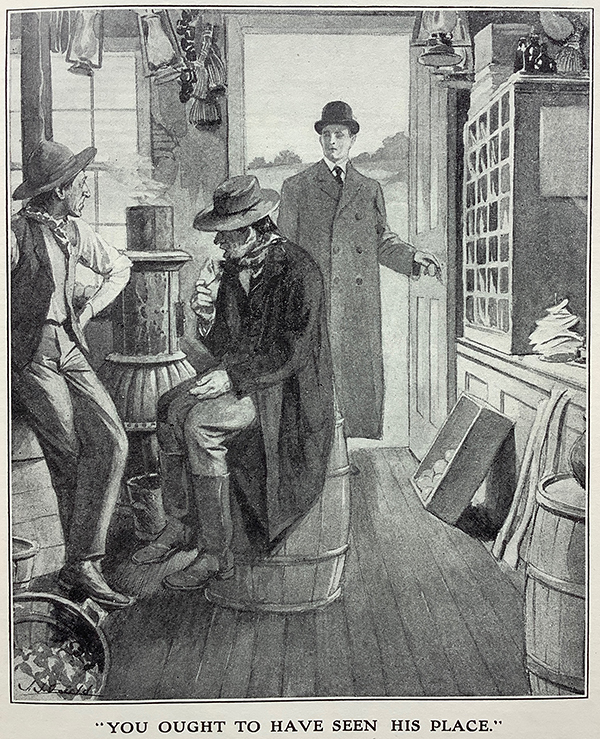
facing p114...The next day noon I struck Falls City, Nebraska. It had taken me eighteen hours to make the trip. To me it seemed as if I were going into a new world and I was surprised to find, when I reached Nebraska, that men way out there were about the same sort of clothes that they did in St. Louis. I would not have been surprised a bit if some Indian had come out of the bushes and tried to scalp me. The depot was a mile and a half from the hotel. Here I took my first ride in an omnibus. The inside of that old bus, the red old-cushioned seats and the advertisements of a livery stable, a hardware store, and “Little Jake’s Tailor Shop” were all new to me. Mud? I never saw mud so deep in my life. It took us an hour to get up town...
120 : link
- Carl W. Dipman. The Modern Hardware Store. New York : Good Hardware / The National Magazine of the Hardware Trade / The Butterick Publishing Company, 1929.
The old-fashioned hardware store was to a large extent a store room. The dealer was a storekeeper. But the modern hardware store must be a scientific salesroom. The dealer must be a modern sales engineer. ¶ In this evolution there has come into use a new type of salesmanship. For the want of a better term let us call it silent salesmanship. ¶ While personal salesmanship still has and always will have its place in the hardware business yet it must be supplemented with this new silent salesmanship.
There is an emphasis on “open display” of merchandise, design of table and wall displays; store layouts. Many photographs. I gather that much or all of the contents are taken from the Good Hardware trade magazine.

- Evelyn L. Ewing. “The Hardware Store,” chapter 8 in Larkspurs & Asparagus, drawings by John Boone (Oklahoma City, Spectragraphic Press, 1976)
“Papa bought the hardware store from Old Man Price about the time I entered junior high school. I was so proud of the big sign, Bolton’s Hardware, that I grew a little bit in stature every time I saw it for the next few years.
I learned much about life and living in that store. First I was surprised and shocked to learn that nuts and bolts were sold by the pound the same as navy beans were...”
p35contents —
I.
II.
III.
IV.
V.
VI.
VII.
VIII.
IX.
X.
XI.
XII.
XIII.
XIV.
XV.
XVI.
XVII.
XVIII.
XIX.
XX.
XXI.
XXII.
XXIII.That Was the Day
The Temporary Light
A Glimpse of Death
Old Lizzie
Ku Klux Klan
Spring Rains
My Short Happy Life of Crime
The Hardware Store / they lose the store in the Depression
The Second Table
Our Magnificent Model A
Papa’s Birthday
Hair
Long Underwear
Let’s Radio Tonight
The First Picture Show
Forbidden Love
The Right to Work
Mama Was Liberated
The Gentleman Caller
No Work, No Desks, Just Cubbies
Papa Was a Psychologist
Outhouse Memories
Larkspurs and Asparagus / flowers for Memorial Day observancefrom back cover —
Evelyn Ewing is a teacher of English in Mooreland High School, Mooreland, Oklahoma, where she has been employed for the last nineteen years. She is well-known as an after dinner speaker and a speaker for special occasions in Northwest Oklahoma and has entertained many audiences during the past several years.
Mrs. Ewing was born Evelyn Bolton, one of the five daughters of Luther and Martha Bolton, in Jenks, Oklahoma, and lived there among the surroundings she describes in Larkspurs and Asparagus. She entered Central State Teachers College at Edmond, Oklahoma, in 1934 and received her Bachelor’s Degree in education from that institution in 1938. She has done graduate work at various Oklahoma colleges.
Mrs. Ewing likes to write and has had articles published in several Oklahoma magazines and newspapers.
- Charles P. Forbes. The merchant’s memorandum and price book : adapted to the principal branches of mercantile business. Particularly designed as a pocket memorandum for the country trader. Boston: Published by John Marsh, 96 & 98, State Street. 1827.
A digitized copy of a microfilmed copy of this item (at Harvard) is available in the Goldsmiths’-Kress series (number 25278.5). The book is described as xvi, 182, and 16cm high. Pagination quite confused, but there are 185 printed leaves. The scan or microfilm appears to omit blank pages.
The author’s name appears only on page ii, in the copyright notice.
The book contains: Preface iii-v; Errata vi; Contents vii-ix; Subscribers’ Names, with their Residence and Occupation (and classified by hardware, dry goods, crockery, WI — West Indies? — goods, and books & stationary [sic]) for Boston, New York Philadelphia, Baltimore and Albany, xi-xvi; and then the lists as described in the TOC, running pp (9)-182.
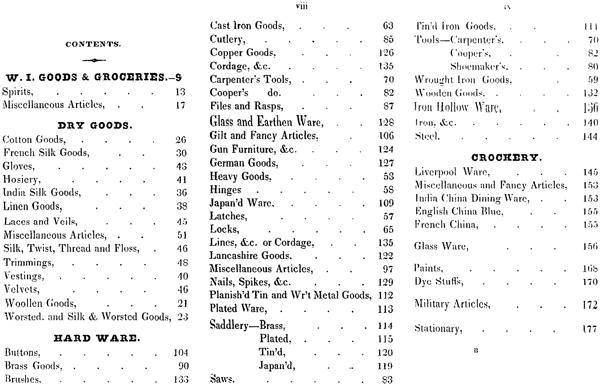
TOC, three pages vii-ix, Charles P. Forbes. The merchant’s memorandum and price book (1827).
Note that under “hard ware” is listed not only carpenter’s, cooper’s, and shoemaker’s tools, but “buttons,” “glass and earthen ware” and “wooden goods.” The distinction is, indeed, hardness: we find “W.I. Goods” (13-17), including soda and other alkalis, coffee, cotton, cocoa, fish, fruit, molasses, oil, rice, spirits, sugar, spices, etc.; followed by “dry goods” and, near the end, “crockery.” The last four entries are a miscellaneous list of “paints,” “dye stuffs,” “military articles” and “stationary.”
This book is an instance of the relationship of language (and list-making) to hardware selling; it is a kind of “wish list,” as well, and akin to the “want books” maintained by hardware store clerks in more recent years, and probably even today. Blank want books — like ledger interleaves — also ended up in the hands of sons and daughters, for their own writing and drawing.
I provide these images of (the printed content) of several pages with some qualms: (1) haven’t (yet) sought permission; (2) they are of digitizations of b&w microfilm that completely loses a sense of their disposition on a page: how much space at left and right, for annotations. Will seek to do better in both ways.
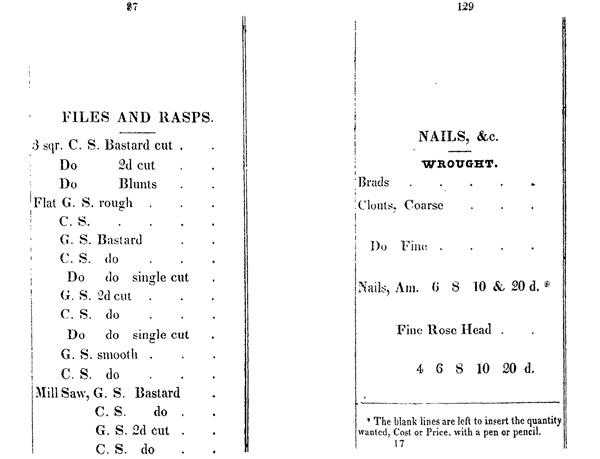
printed content of pages 87 and 129: both include wide left and right margins, but cannot determine width from available images, Charles P. Forbes. The merchant’s memorandum and price book (1827).
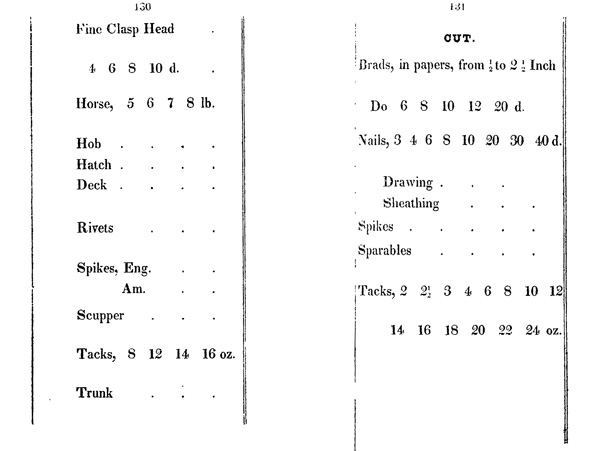
printed content of pages 130 and 131: both include wide left and right margins, but cannot determine width from available images, Charles P. Forbes. The merchant’s memorandum and price book (1827).
The space at left of each text block is for noting quantity needed (written “preparatory to visiting market;” the space at right of each text block is for noting the “cost and price of those articles for which it is necessary to have a price book” (and thereby maintain one’s margin on the item). I show all the nail entries, because of their intrinsic interest (to me).
Sparable? derives from “sparrow-bill” (because it has the shape of a sparrow’s bill) : A small headless wedge-shaped iron nail (stouter than a sprig), used in the soles and heels of boots and shoes. (OED (Second edition)).
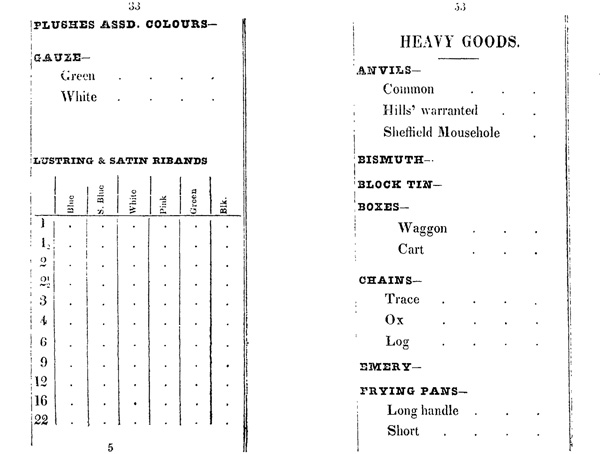
printed content of pages 33 and 53: both include wide left and right margins, but cannot determine width from available images, Charles P. Forbes. The merchant’s memorandum and price book (1827).
The table (on page 33) for “Lustring & Satin Ribands” extends for two subsequent pages; it provides an example of an arrangement frequently encountered in later telegraphic codes, where the intersection of column and row yields — rather than a notation of stock on hand, or price — instead a single codeword.

- Walter A. Friedman. Birth of a salesman : the transformation of selling in America. Cambridge: Harvard University Press, 2004

- Carolyn M. Goldstein. Do It Yourself: Home Improvement in 20th-Century America (Princeton Architectural Press, 1998). Includes a photograph of Fred P. Johnson’s store in 1924, but no mention that Mr. Johnson was the inspiration for the Mr. Oswald series, drawn by Johnson’s son Russ. Excellent study.
- Fred C(harters). Kelly (1882-1959).“A Soft Spot for Hardware,” in The Rotarian 93:6 (December 1958): 28-30. Google scan here.
Looks at changing merchandise mixes in hardware catalogues of the late 19th century — evidently the catalogues of Hibbard, Spencer, Bartlett & Co. of Chicago, founded by William Gold Hibbard, “that recently celebrated its centennial.” Kelly was the author of that firm’s history — Seventy-five years of Hibbard Hardware (1930).

- Shannon Mattern, “Community Plumbing :
How the hardware store orders things, neighborhoods, and material worlds” (July 2018), at Places Journal (July 2018) :
link.

- Cecil A. Meadows. The Victorian Ironmonger. (Shire Album No. 32.) Alesbury (Bucks.): Shire Publications, 1978 (2nd edition 1984).
A brief illustrated study, quite good. Author apprenticed “in the late 1920s, to one of the last of such ironmongers trading in Norwich.” Contents: Origins of the name and trade; Trade signs; The growth and decline of the furnishing ironmonger; Supplies and inventions; Purchasing methods; Trading and delivery; Price codes and stock marking; The office; Manufacturing; The stocks; Bygones.

- Saunders Norvell (1864-1949). Forty Years of Hardware. Illustrations by Serena Summerfield. New York: Hardware age, [c1924]
Saunders played many roles in the hardware business — shop clerk, traveling salesman, sales manager, head of a hardware concern, and later writer. He is described in Friedman’s Birth of a Salesman (2004).

- Walter H. Olson. Old-Fashioned Hardware Stores : Descriptions, stores and advice (2015) : link
excellent. table of contents shown below.
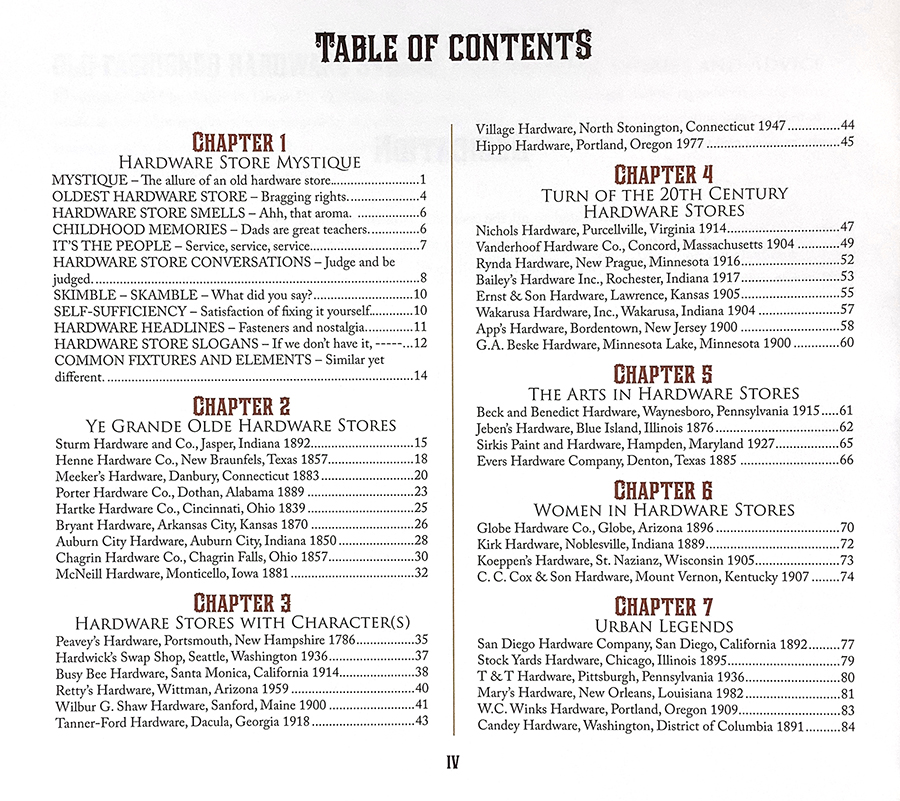
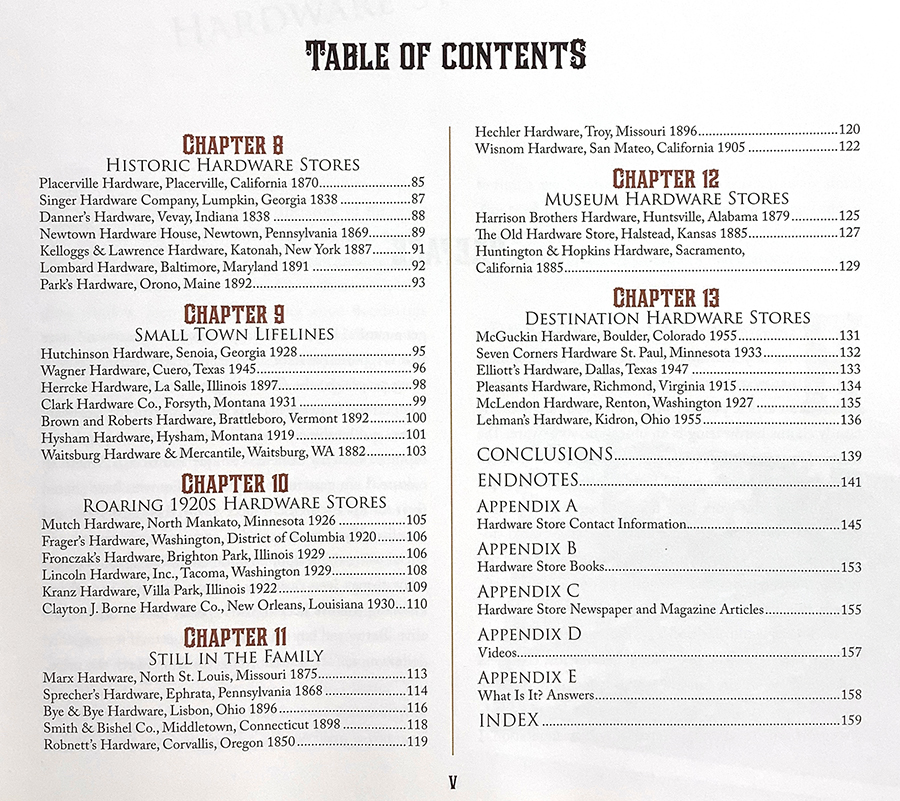
profiles of 75 stores in 28 states. somewhat nostalgic. good bibliography, excellent index.

- An Omnibus Store, in “Mercantile Miscellanies,” taken from The Philadelphia Merchant, in Hunt’s Merchant’s Magazine and Commercial Review, Conducted by Freeman Hunt, A.M. 32 (January – June 1855) : link (Bodleian, google).
UC copy (via hathitrust) : link“Division of trade into distinct branches appears to be in the natural order of things. Even where two or more branches are yet united in the same establishment, there is an avoidance of incongruity—as when fur robes are kept for sale in a hat store—or where extremes meet, as in straw bonnets and boots and shoes. The tendency, in all great commercial marts, is to simplification...
One who is familiar with this subdivision of trade, and who knows little even by hearsay of the rough and tumble of mercantile life in newly or sparsely settled country districts, would be greatly amused by spending a day in a specimen omnibus store of some regions in the West... His store is indeed an aggregation of stores.”The passage goes on to list, in an adumbrative literary style, all of the stores contained within this single enterprise —
“It is a grocery store, with tea, sugar, rice, coffee, spices, molasses, dried fruits, &c.
It is a hardware store, with cutlery in variety, axes, rifles, divers mechanics’ tools, kitchen utensils, agricultural implements, bar-iron, nails, &c... It is a book and stationery store, equal to the ordinary requirements of the vicinity...”Hunt’s Merchant’s Magazine offers reports, analysis and statistical tables representing so-called “difficult typography.”
Freeman Hunt (1804-58), publisher; bio at Lamb's biographical dictionary of the United States, edited by John Howard Brown, vol. 4 (1901) : link

- Some beautiful photographs of eisenwaren — German for ironware — interiors are included in Max Galli, Vom Charme der alten Warenwelt (1992).
A recent trip to Turkey reminds me that the concept of “hardware” retailing is not universal, but falls within different genres in different countries, different times. I imagine a book that would give a sense of those different genres, inspired in part by the Galli book.

- William G. Smythe. “The Hardware Trade in the United States,” in The Chatauquan 29:2 (May 1899) : 114-119.
More about manufacturing than retailing, a belles-lettristic account, e.g., Perhaps when all is said no hardware device adds more to the comfort and security of every-day life than the various contrivances for keeping the wrong person out.... Find here.
- Vince Staten. Did Monkeys Invent the Monkey Wrench?: Hardware Stores and Hardware Stories (1996).
Author “grew up at the register of (his> father’s hardware store,” in Kingsport, Tennessee.
>Good observation at p234: “No hardware store can be completely typical of the industry.”

- Jane Stern, “Hardware Store Doppelgänger” in (at?) The Paris Review (April 3, 2017) : link
Only in hardware store is author recognized for being someone she isn’t (an opera singer, an S&M Madam).
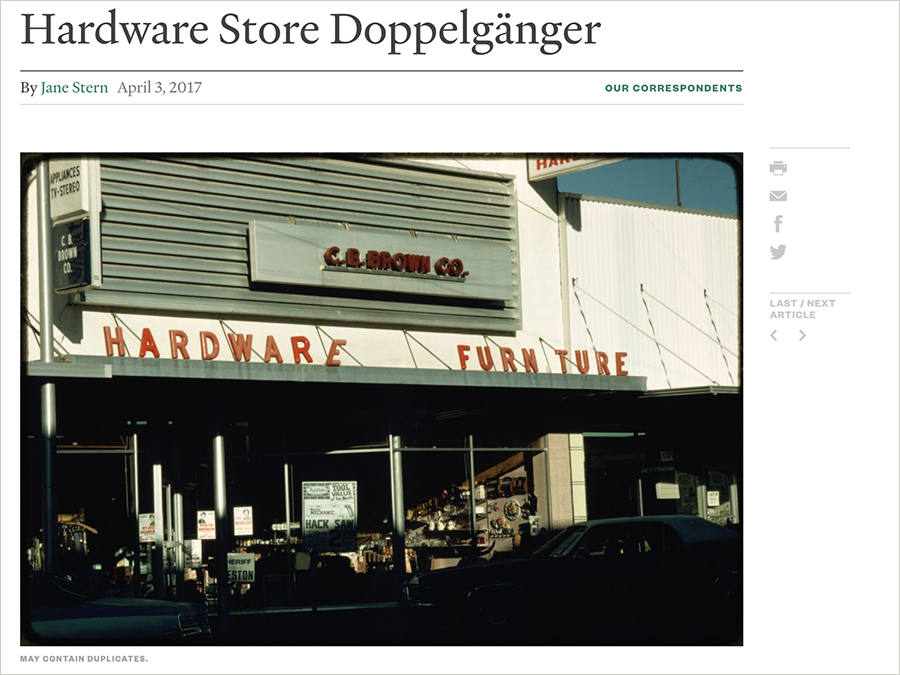
screen shot of above (“May contain duplicates” included) : an undated (but not current) photo of C. B. Brown Co., Hardware and Furniture, 221 South Bridge Street, Winnemucca, Nevada
street view : link“Jane Grossman Stern and Michael Stern (both born 1946) are American writers who specialize in books about travel, food, and popular culture.”
wikipedia : link
- Paul E. Teague. “My Alma Mater: The Hardware Store.” Design News 59:8 (2 June 2003): 14
copyright is Reed Business Information, a division of Reed Elsevier.“...hardware stores have been a great source of information and inspiration for me and for countless others. Remember your first solo trip to a hardware store?...”

- Robert Klose. “Hardware the Old-Fashioned Way,” in collection of author’s essays Small Worlds: Adopted Sons, Pet Piranhas, and Other Mortal Concerns (University of Missouri Press, 2006): 129-30. And in its original setting, Christian Science Monitor (28 June 2000) here. (Search the CS Monitor for “hardware store” + klose — hardware stores turn up a lot in his essays.)

- The National Building Museum in Washington D.C., although focussed on architecture, has also hosted exhibits on corner stores, tools as art, and home improvement. : link
NBM published the journal Blueprints (1981-2008); some backlist articles are archived : link.

- The North American Hardware and Paint Association (formerly the National Retail Hardware Association) : link.
Once upon a time offered links to retailer sites, some of which feature historical material, e.g., that of Cornell’s Hardware in New York, now operating under new ownership (Aubuchon) :
link.Still publishes Hardware Retailing : link

- Hardware Dealer’s Magazine (1910)
Listen in on this “question box” discussion about merchandising (1) second-rate goods as a response to “racket store competition” and (2) selling clocks and watches, if jewelers oughtn’t to be selling cutlery, in March 1910. The evolution of retail genres and merchandising proprieties, and the debates that accompany them, goes way back. Page 611 includes a discussion of getting into sporting goods, and catering to “the ladies’ trade.”
Mutability of the hardware store “genre” happens gradually. Week after week, the buyer goes through his want book with the visiting salesmen from his jobbers. Micro decisions are made about whether to replenish, increase or reduce supply of one product or line, or drop it entirely, and/or add another. Over and over, week after week, year after year. The store will go from castiron cookware to all manner of pots and pans and housewares generally, and then decades later get out of them entirely. Some dealers took on radios when they were new, later televisions. Some probably got out of hardware entirely for these new lines, that performed well for them.
- Hardware Dealer’s Magazine (1908)
Cover page, January issue. But editorial copy starts here.
Try “A trip through a thoroughly modern jobbing house : systematized business,” here (regards the Norvell-Shapleigh Hardware Company, in Chicago). Jobbers versus retailers here.
- Good Hardware
Styled “The National Magazine of the Hardware Trade,” this retail-trade journal was published by Butterick, also publisher of the Delineator fashion magazine.
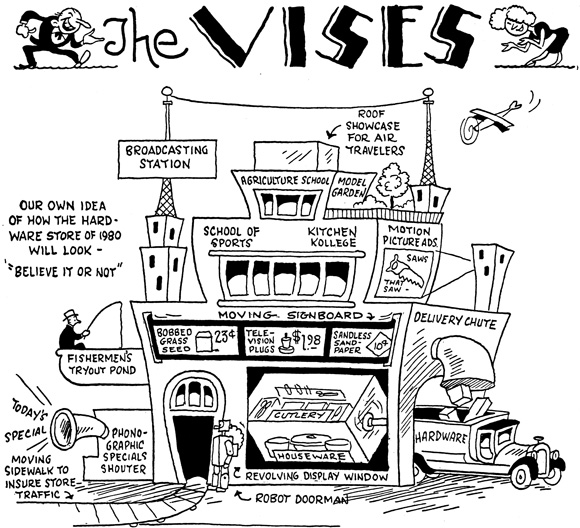
The cartoon above appeared in the same May 1931 issue that carried a long essay entitled “Just Imagine,” in which O. L. Davis asks and answers, “If this is the city of 1980, What will the hardware store of the future be like?.” In the story, Harry is somehow transported from 1931 to 1980, where he is amazed by the hardware store of tomorrow. For example —
“I used to have more paint in my store than you have here,” said Harry.
“Yes, I’m sure you did, but remember that was in the lead and oil era when it was necessary to stock a complete run of sizes and colors in several kinds of paint, such as house paint, interior paint, floor paint, cement paint, enamels, etc., all different and made for specific uses.”
“You are correct, we did,” said Harry.
“One line of this ‘Super-Synthetic’ is all we need to carry today. One paint serves all purposes, exterior, interior, under water or on cement floors. It adheres to all paintable surfaces and lasts more than three times as long as the old-time paints...”Time-traveling Harry is also amazed by television, which is used to “demonstrate articles the customer had asked for but was not carried in stock by the store.”
But the story shifts from merchandising and the larger, cleaner, quieter, brighter store interior, to the nature of competition in 1980. The solution was a binding of manufacturer, jobber and dealer, all in a battle to defeat the mail-order houses and the chains. Indeed, at least half of the article is devoted to this topic, and may presage the cooperative initiatives of John Cotter and others, in the 1950s and 1960s.
On John Cotter and the TrueValue chain, see
- Hoover’s Profile: “True Value Company,” a quite good article by Ellen D. Wernick, updated by Christina M. Stansell. : link (wayback machine, captured 2008)
No date, most recent entry in “Further Reading” is 2005. - Edward R. Kantowicz. John Cotter: 70 Years of Hardware (Chicago: Cotter & Company, 1987).
Some hardware retailers resisted the Cotter organization, sensing that it would threaten their independence. For some, Cotter was akin to socialism; they may also have enjoyed their years-long weekly conversations with favorite salesmen. The bias was certainly held within the McVey family; I put it aside as I read Kantowicz’s excellent book.

- R(ichard) R(ichardson) Williams, compiler and editor. Hardware Store Business Methods (New and Enlarged Edition). New York, David Williams Company, 1901 : link
Among “Rules and Regulations for the Hardware Store” (pages 1-6) are these: 1. “Keep your eyes on the front door. Customers should be waited on promptly and pleasantly.” 46. “Conversation with the bookkeeper, or the cashier, except on business, interferes materially with the work. Do not forget this.”
Cost Marks (pages 153-156) includes these illustrations of same.

The cipher systems shown below are not related to the above; they are reminiscent of the (pre-Braille) blind alphabet submitted by Robert Milne, himself blind, in a competition sponsored by the Society of Arts for Scotland, in 1836, a section of which is shown here :

They also relate to some of the telegraphic alphabets, such as the Dean alphabets described here.
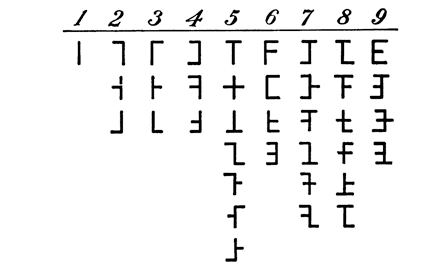
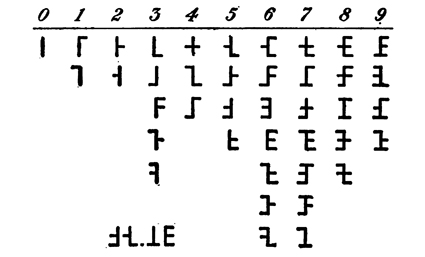
"The principle upon which the cost mark is constructed is that the dashes at the top of the perpendicular lines, on either side, count for one; those at the middle, on either side, count for two, while those at the bottom of the perpendicular lines, on either side, count for three. A perpendicular line alone represents 0. The mark at the bottom of the cut is given as an example showing how a cost mark may be written, in which the same figures are repeated while using different signs. The example, it will be seen, reads $55.66... ¶ From the examples given it will be readily seen that a large variety of diagrams can be made the basis or key from which a cost mark can be evolved.
Fully indexed (pp 221-227). Advertisements for other Iron Age publications include Multiple Index Price Books, with their index rerum-style classification format.
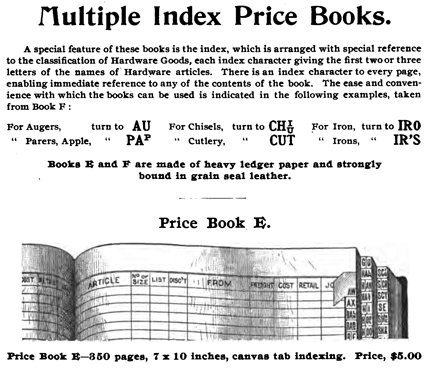
Apologies for this long digression on a minor part of this textbook. From the same book, see “Arrangement of Catalogues and Price-Lists” (pp 93-102), here
 from Williams, Hardware Store Business Methods, 1901.
from Williams, Hardware Store Business Methods, 1901.
So organized! Roughly contemporaneous with the Sweet’s Catalogue (first appeared in 1906), Library Bureau products, &c., &c. Note copies of Iron Age stacked second from top, at left. Can the system hold up once the cabinet is full? Luckily, there’s an index, and numbered shelves and drawers.
17 June 2011; 2 July 2023